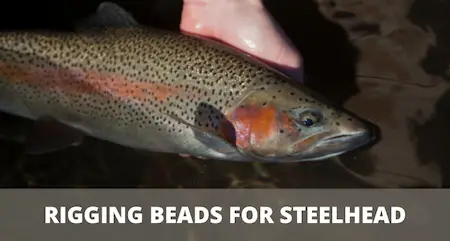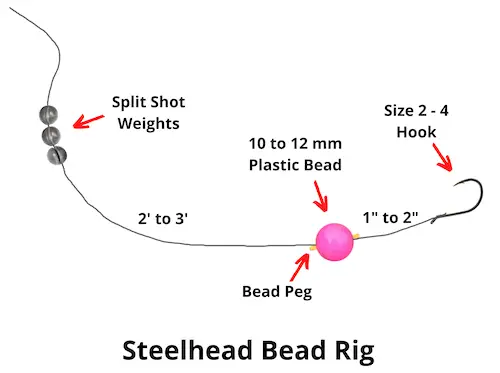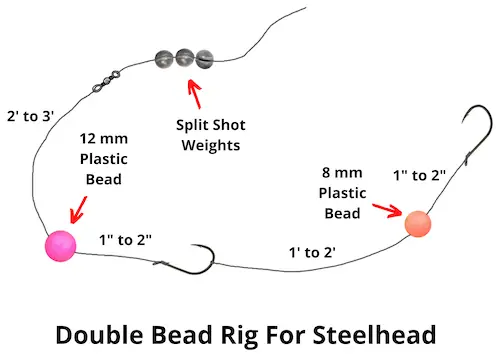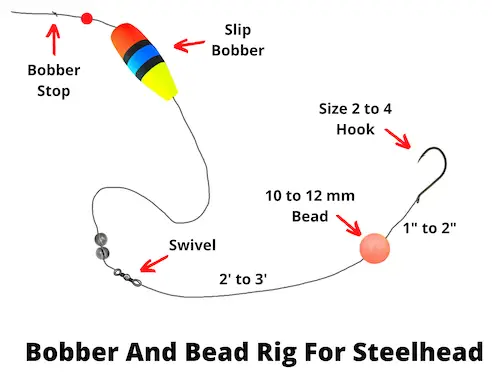Steelhead Bead Rig (3 Setups You Need To Know)
UPDATED 03 NOVEMBER 2023
by Robert Ceran
Steelhead bead fishing is one of the most effective ways to catch this beautiful trout species.
Plastic beads are so effective for catching steelhead because they are designed to resemble salmon eggs carried downstream with the river current, which often provides an irresistible bait for steelhead, as they regularly feed on real salmon eggs.
However, in order to fish effectively with steelhead beads, you need to know how to tie a good bead rig for steelhead.

In this article we’ll show you the best ways of rigging beads for steelhead, and will also share our best tips on when and how to fish it.
How do you rig beads for steelhead?
The best way to rig a bead for steelhead is by attaching a 10 to 12 mm bead to the leader line 1 to 2 inches above the hook.
This setup is usually fished with a slip bobber rig, and is one of the most effective steelhead baits, since it resembles a salmon egg drifting with the current (a favorite steelhead food).
Now let’s talk about the details of how to set up this rig, and cover when and how to use it to catch steelhead.
Bead rig for steelhead
The bead rig is one of the best rigs for steelhead, and has been catching steelhead successfully for many decades.

The principle behind it is very simple: a colored bead is rigged next to a hook, and then drifted down the river, resembling a tasty salmon egg.
How to tie it: The best way to rig a bead for steelhead depends on whether you’re using hard beads or soft beads. In either case you should aim to rig about 1 to 2 inches of line between the bead and the hook.
The reason why you need this distance between the bead and the hook is because a bead can prevent effective hook ups if it’s placed too close to the hook (which is especially true for hard beads).
If you’re using a hard bead, one of the easiest ways to rig it is with a double loop, where you pass the line 3 times through the bead before tying the tag end to the hook.
If you’re using a soft bead, it’s necessary to tie a small glass bead to the line in order to stop the soft bead from sliding on to the hook (see below for more details).
When to use it: The bead rig can be used for steelhead in any conditions with enough current.
The current is necessary to drift the bead rig along the river, just like a single salmon egg that has been washed downstream from spawning grounds further upstream.
How to use it: The most common way to fish a bead rig is with a slip bobber, but in shallow rivers you can also use a fixed bobber.
If you’re fishing in strong current, and need the rig to get down into the strike zone effectively, another great option to use is a drift rig with pencil lead, that you can drift along the bottom of the river bed.
How do you attach beads to fishing line?
There are four main ways to attach beads to fishing line:
- Use a double loop knot to tie the bead onto the line
- Use a bead peg (or toothpick) inserted into the hole of the bead
- Use a bobber stop to prevent the bead from sliding on to your hook
- Use a small glass bead to stop the bead from sliding on to your hook
The first three methods to peg a bead are most commonly used with hard beads, while the fourth is most often used with soft beads.
Rigging soft beads for steelhead
In recent years, many steelhead anglers have started using soft beads instead of hard beads for steelhead, and as their name suggests, their main difference is that they are squishy and soft, which means you have to use different methods for attaching them to the line.
The best way to do this is with a small glass bead that you tie to the leader line between the bead and the hook, which prevents the bead from sliding further down.
Thread your leader line twice through the glass bead, and then pass the end with the hook 5 to 7 times through this loop, and cinch it down.
This creates a barrier between the hook and the soft bead, so it can’t slide further down the leader. And by the way, soft beads also make a great bait for trout fishing.
Double bead rig for steelhead
The double bead rig enables you to increase your chances of hooking a steelhead by having two bait presentations in the water at the same time.

How to tie it: Set up your first bead just like you would with a regular bead rig. Then tie another leader to the bend of your first hook, and thread a bead onto it.
Measure out about 1 foot of leader line, peg the bead to the line, and then tie on a second hook 1 to 2 inches below the second bead.
When to use it: The double bead rig is ideal when you are allowed to have more than one hook on your line (which isn’t the case everywhere, so be sure to check your local regulations before you use it).
Having two beads in the strike zone at the same time not only increases your chances of catching fish, it also allows you to test out different bead sizes and colors in parallel, which helps to zero in on the winning combination faster.
How to use it: The double bead rig is most often fished with a slip bobber, but can also be used with a fixed bobber, or with a drift fishing rig.
Bobber and bead fishing rig for steelhead
The most common way to fish a bead rig is with a slip bobber, which allows you to cover a wide range of different depths quickly and easily, as you systematically fish each section of a river.

How to tie it: Start by tying a bobber stop on to your main line (which can be either monofilament or braided line), followed by threading on a small glass bead and then the slip bobber.
Next, tie the line to barrel swivel, and add as many split shot weights between the swivel and your float as are necessary to weigh down your rig in the water.
Finally, tie a 2 to 3 foot fluorocarbon leader (8 to 12 lb test is ideal), and rig your bead plus hook at the end of the leader.
When to use it: This is the best all-around rig for fishing a bead setup, since it works for many different fishing situations, and can easily cover many different water depths.
However, if you’re mainly fishing in shallow water (less than 5 feet deep), you can substitute a fixed bobber for the slip bobber.
How to use it: Cast your rig 45 degrees upstream from where you are, and let the current drift your bobber downstream, all while making sure to mend your line by keeping it off the water as much as possible.
That allows the current to pull your bobber (and hence your bead rig) downstream naturally, which is most effective in terms of triggering steelhead bites. This setup also makes a great salmon rig for bank fishing.
What is the best bead size for steelhead?
The best all around bead size for steelhead is 10 to 12 mm. However, you can also go smaller (down to 6 mm), or larger (all the way up to 20 mm), and the best size on any given day needs to be determined by testing.
If you’re allowed to use a double bead rig on your river, a great option is to use two different size beads in parallel, which can help you to figure out what size works best on that particular day.
I like to start with an 8 mm bead at the bottom, and a 12 mm bead above it.
What size hooks should you use for steelhead beads?
The best size hook to use for steelhead beads depends on the size of the beads you’re using:
- 6 mm beads: Size 6 to 8 hooks
- 8 mm beads: Size 4 to 6 hooks
- 10 mm beads: Size 2 to 4 hooks
- 12 mm beads (or larger): Size 1/0 to 2 hooks
Keep in mind that most beads tend to float in the water, so the hook helps to weigh down the bead and get it down into the strike zone.
Also, the bigger the bead, the more likely you are to catch bigger steelhead with it, and thus need a larger hook to hook them effectively.
